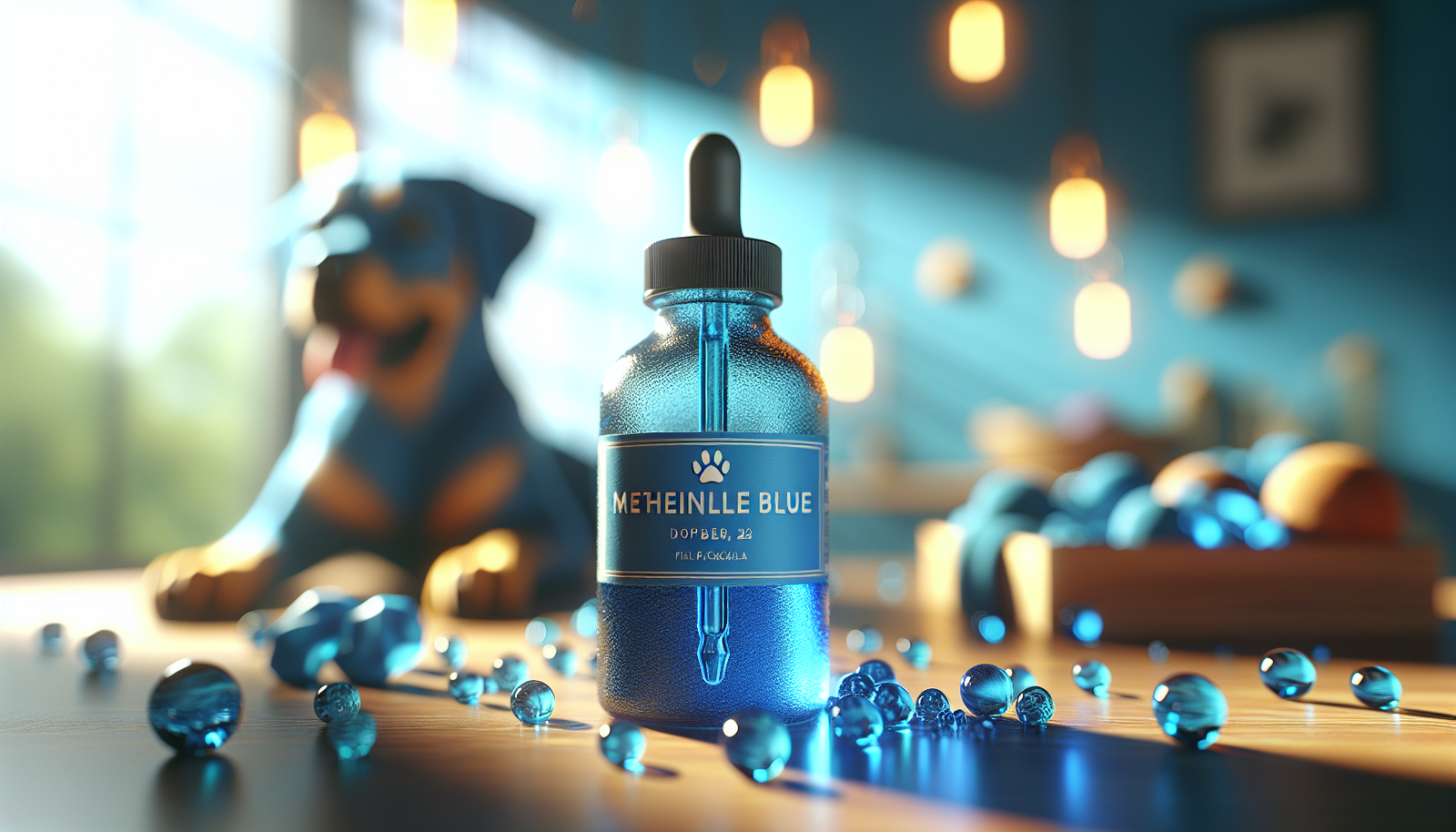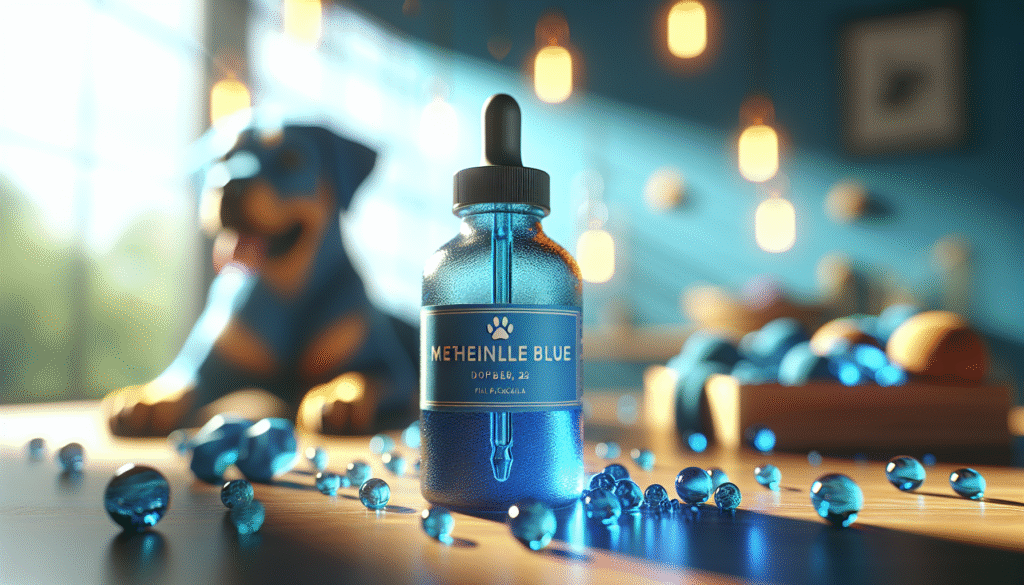
Have you ever considered using methylene blue for your pet? This versatile compound has therapeutic applications that can significantly benefit your furry companions. Understanding the proper usage guidelines for methylene blue in pets is crucial to ensure their health and safety.
What is Methylene Blue?
Methylene blue is a synthetic dye with a long history in both medical and veterinary practices. Originally invented in the late 19th century, it has found use as an antiseptic and treatment for certain medical conditions. In the context of veterinary medicine, its applications range from treating infections to acting as an antidote for certain types of poisoning. You will find that methylene blue is especially renowned for its ability to enhance oxygen delivery in tissues, making it a valuable option in specific clinical scenarios.
Chemical Structure and Properties
Methylene blue is a thiazine dye and is known for its deep blue color. Its structure consists of a phenothiazine derivative that enables it to form complexes with various biological molecules. The compound is water-soluble, which facilitates its administration to pets in various forms, including solutions and powders. The unique properties of methylene blue allow it to interact with cellular components, which is part of what makes it effective in clinical applications.
Uses of Methylene Blue in Veterinary Medicine
Understanding the applications of methylene blue in veterinary medicine can be helpful for any pet owner. It’s often used in cases of specific conditions and emergencies. However, the key lies in recognizing the appropriate scenarios for its usage.
Treatment of Methemoglobinemia
One of the primary uses of methylene blue in pets is for the treatment of methemoglobinemia, a condition where hemoglobin is unable to effectively release oxygen to the body’s tissues. This condition can occur due to overdosing on certain drugs, exposure to chemicals, or underlying medical issues.
How it Works: Methylene blue acts as a methylene blue reductase, converting methemoglobin back to hemoglobin. This restoration allows for better oxygen transport, which improves overall tissue oxygenation.
Antimicrobial Properties
Methylene blue possesses antimicrobial properties that are effective against a range of pathogenic organisms. This can be particularly advantageous in treating bacterial and some types of fungal infections in pets.
Clinical Applications:
- Topical use for superficial skin infections.
- Irrigation solutions for surgical wounds.
Antidote for Poisoning
Another critical application of methylene blue is as an antidote for certain types of poisoning. It can be particularly effective against poisons that lead to methemoglobinemia, specifically those that involve exposure to nitrates or certain medications.
Supportive Care in Ailments
In cases of other ailments, methylene blue can be part of a supportive care treatment plan. For instance, it may be used in animals undergoing surgery or those with compromised respiratory function, as it can enhance oxygen delivery.

Administration Guidelines
Before you decide to use methylene blue for your pet, it’s paramount to understand the appropriate administration guidelines. Dosages, methods of administration, and monitoring are all critical components of safe and effective treatment.
Dosage Considerations
The dosage of methylene blue varies based on the specific condition being treated, the size of your pet, and their overall health. It’s crucial to consult with your veterinarian to determine the correct dosage for your specific situation.
| Condition | Dosage | Administration Method |
|---|---|---|
| Methemoglobinemia | 1-2 mg/kg IV over 5 minutes | Intravenous injection |
| Bacterial infections | 1-2 mg/kg PO, depending on severity | Oral administration |
| Poisoning | 1-5 mg/kg IV or IM | Intravenous or intramuscular |
| Supportive care | Varies | As directed by a veterinarian |
Method of Administration
Methylene blue can be administered in several ways:
- Intravenous (IV): This method is usually preferred for emergencies, as it provides the fastest effect, especially in cases like methemoglobinemia or acute poisoning.
- Intramuscular (IM): This can be used when IV access is not easily obtainable, though it may take longer to observe effects.
- Oral (PO): This method is commonly used for more chronic conditions or infections. Tablets or solutions are often flavored for palatability.
Monitoring and Follow-Up
Post-administration monitoring is essential. Your veterinarian will likely recommend follow-up blood tests to assess the levels of methemoglobin and ensure that methylene blue is effectively reversing the condition. Keeping an eye on your pet for adverse reactions or any unusual behavior following administration is also vital.
Risks and Side Effects
While methylene blue can be an effective treatment option, it is not without risks. Understanding potential side effects and contraindications is imperative when considering this treatment for your pet.
Common Side Effects
Some side effects may occur, and it’s essential to recognize them early. Common side effects include:
- Discoloration of Urine: Methylene blue can impart a blue-green color to urine, which is harmless but may concern pet owners.
- Gastrointestinal Upset: Pets may experience vomiting, diarrhea, or reduced appetite after administration.
- Allergic Reactions: Though rare, allergic reactions can occur. Signs may include swelling, itching, or difficulty breathing.
Contraindications
There are specific situations where methylene blue should not be used:
- Pregnant or Nursing Pets: The effects of methylene blue on developing fetuses or nursing animals are not well-studied.
- Pets with G6PD Deficiency: Methylene blue can exacerbate hemolysis in animals with this genetic deficiency.
- Concurrent Use of Certain Medications: Some medications may interact with methylene blue, making it crucial to discuss your pet’s medication history with your veterinarian.

Alternatives to Methylene Blue
In some cases, there may be alternative treatments available. These alternatives depend on the specific condition being treated and your pet’s overall health.
Oxygen Therapy
For cases of severe respiratory distress or methemoglobinemia, oxygen therapy may be a viable option. It involves the direct administration of oxygen to the pet, which can help alleviate hypoxia without the use of methylene blue.
Other Antimicrobial Agents
When treating infections, your veterinarian may suggest alternative antimicrobial agents, especially if methylene blue is deemed unsuitable due to potential risks. These alternatives may provide a more tailored treatment option based on the type of infection present.
Supportive Care
In some instances, supportive care through hydration, nutritional support, and pain management can play a crucial role. This comprehensive approach may mitigate the need for methylene blue, especially in non-life-threatening situations.
Consulting with Your Veterinarian
Before considering the use of methylene blue for your pet, a thorough consultation with your veterinarian is necessary. They will evaluate your pet’s specific condition, history, and overall health to determine the best course of action.
Preparing for the Consultation
When preparing for your veterinarian appointment, consider the following steps:
- Record Symptoms: Note any symptoms your pet is experiencing, including duration and severity.
- List Medications: Prepare a list of medications and supplements your pet is currently taking.
- Ask Questions: Prepare a list of questions to discuss during your appointment, including potential side effects and alternatives.
Importance of Veterinary Supervision
While pet owners may have access to information about methylene blue, it is essential to rely on professional veterinary advice. The nuanced nature of veterinary care means that individual factors must be considered to ensure the safety and efficacy of treatments.
Conclusion
Methylene blue has proven to be a valuable tool in veterinary medicine, capable of addressing a range of serious conditions. However, its application requires careful consideration of dosage, method of administration, and potential side effects. By collaborating with your veterinarian and staying informed, you will be better equipped to make decisions that benefit your pet’s health. Understanding the full scope of methylene blue’s applications allows you to navigate your pet’s medical care with clarity and confidence, ensuring a safe and effective path to recovery.